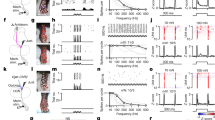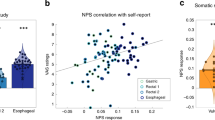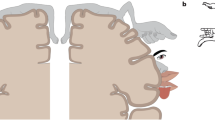Abstract
Information about bodily events is conveyed by primary sensory fibres to higher brain centres through neurons in the dorsal column nuclei (DCN) and spinal dorsal horn. The DCN route is commonly considered a ‘touch pathway’, separate from the spinal ‘pain pathway’, in part because DCN neurons respond to gentle tactile stimulation of small skin areas. Here we report that DCN neurons can additionally respond to gentle and noxious stimulation of viscera and widespread skin regions. These and other experimental and clinical data suggest that the DCN and spinal routes cooperate, rather than operate separately, to produce the many perceptions of touch and pain, an ensemble view that encourages novel approaches to health care and research.
This is a preview of subscription content, access via your institution
Access options
Subscribe to this journal
Receive 12 print issues and online access
$209.00 per year
only $17.42 per issue
Buy this article
- Purchase on Springer Link
- Instant access to full article PDF
Prices may be subject to local taxes which are calculated during checkout
Similar content being viewed by others
References
Spiller, W.G. & Martin, E. The treatment of persistent pain of organic origin in the lower part of the body by division of the flnterolateral column of the spinal cord. JAMA 58, 1489–1490 (1912).
Willis, W.D. Jr & Coggeshall, R.E. Sensory Mechanisms of the Spinal Cord, 2nd edn (Plenum, New York, 1991).
McMahon, S.B., Lewin, G.R. & Wall, P.D. Central hyperexcitability triggered by noxious inputs. Curr. Opin. Neurobiol. 3, 602–610. 1993.
Fields, H.L. & Liebskind, J.C. (eds) Pharmacological Approaches to the Treatment of Chronic Pain: New Concepts and Critical Issues (IASP Press, Seattle, 1994).
Gybels, J.M. & Sweet, W.H. Neurosurgical treatment of peristent pain. in Pain and Headache, vol 11 (ed. Gildenberg, P.L.) 1–442 (Karger, Basel, 1989).
Maslany, S., Crockett, D.P. & Egger, M.D. Soniatotopic organization of the dorsal column nuclei in the rat: Transganglionic labelling with B-HRP and WGA-HRP. Brain Res. 564, 56–65. 1991.
Berkley, K.J., Budell, R.J., Blomqvist, A. & Bull, M.S. Output systems of the dorsal column nuclei in the cat. Brain Res. Rev. 11, 199–225. 1986.
McMahon, S.B. & Wall, P.D. Plasticity in the nucleus gracilis of the rat. Exp. Neurol. 80, 195–207. 1983.
Nathan, P.W., Smith, M.C. & Cook, A.W. Sehsory effects in man of lesions of the posterior columns and of some other afferent pathways. Brain 109, 1003–1041. 1986.
Berkley, K.J., Robbins, A. & Sato, Y. Functional differences between afferent fibers in the hypogastric and pelvic nerves innervating female reproductive organs in the rat. J. Neurophysiol. 69, 533–544. 1993.
Berkley, K.J., Wood, E., Scofield, S.L. & Little, I.M. Behavioral responses to uterine or vaginal distension in the rat. Pain 61, 121–131. 1995.
Berkley, K.J., Hubscher, C.H. & Wall, P.D. Neiironal responses to stimulation of the cervix, uterus, colon and skin in the rat spinal cord. J. Neurophysiol. 69, 545–556. 1993.
Berkley, K.J., Guilbaud, G., Benoist, J.M. & Gautron, M. Responses of neurons in and near the thalamic ventrobasal complex of the rat to stimulation of uterus, cervix, vagina, colon and skin. J. Neurophysiol. 69, 557–568. 1993.
Apkarian, A.V., Bruggemann, J., Shi, T. & Airapftian, L.R. A thalamic model for referred pain. in Visceral Pain (ed.Gebhart, G.F.) 217–259 (IASP Press, Seattle, 1995).
Cliffer, K.D. & Giesler, G.J. Jr Postsynaptic d0rsal column pathway of the rat III. Distribution of ascending afferent fibers. J. Neurosci. 9, 3146–3168. 1989.
Cechetto, D.F. Central representation of visceral function. Fed. Proc. 46, 17–23. 1987.
Hubscher, C.H. & Berkley, K.J. Responses of neurons in caudal solitary nucleus of female rats to stimulation of vagina, cervix, uterine horn and colon. Brain Res. 664, 1–8. 1994.
DeLorey, T.M. & Olsen, R.W. GABA and glycine.in Basic Neurochemistry: Molecular, Cellular, and Medical Aspects5th edn (eds Siegel, G.J., Agranoff, B.W., Albers, R.W. & Molinoff, P.B.) 389–399 (Raven, New York, 1994).
Gahery, Y. & Vigier, D. Inhibitory effects in the cuneate nucleus produced by vago-aortic afferent fibers. Brain Res. 75, 241–246. 1974.
Rigamonti, D.D. & Hancock, M.B. Viscerosomatic convergence in the dorsal column nuclei of the cat. Exp. Neurol. 61, 337–348. 1978.
Feldman, S.G. & Kruger, L. An axonal transport study of the ascending projection of medial lemniscal neurons in the rat. J. comp. Neurol. 192, 427–454. 1980.
Pfaff, D.W., Schwartz-Giblin, S., McCarthy, M.M. & Kow, L.M. Cellular and molecular mechanisms of female reproductive behaviors. in The Physiology of Reproduction, 2nd edn, vol 2 (eds Knobil, E. et al) 107–220 (Raven, New York, 1994).
Neuhuber, W. The central projections of visceral primary afferent neurons of the inferior mesenteric plexus and hypogastric nerve and the location of the related sensory and preganglionic sympathetic cell bodies in the rat. Anat. Embryol. 164, 413–425. 1982.
Coggeshall, R.E. Unmyelinated primary afferent fibers in the dorsal column, a possible alternate ascending pathway for noxious information. in Recent Achievements in Restorative Neurology, vol 3, Altered Sensation and Pain (eds Dimitrijevic, M.R., Wall, P.D. & Lindblom, U.) 128–131 (Karger, Basel, 1990).
Giuffrida, R. & Rustioni, A. Dorsal root ganglion neurons projecting to the dorsal column nuclei of rats. J. comp. Neurol. 316, 206–220. 1992.
De Pommery, J., Roudier, F. & Menetrey, D. Postsynaptic fibers reaching the dorsal column nuclei in the rat. Neurosci. Lett. 50, 319–323. 1984.
Weinberg, R.J. & Rustioni, A. Brainstem projections to the rat cuneate nucleus. J. comp. Neurol. 282, 142–156. 1989.
Cliffer, K.D., Hasegawa, T. & Willis, E.D. Responses of neurons in the gracile nucleus of cats to innocuous and noxious stimuli: Basic characterization and antidromic activation from the thalamus. J. Neurophysiol. 68, 818–832. 1992.
Dostrovsky, J.O. & Millar, J. Receptive fields of gracile neurons after transection of the dorsal columns. Exp. Neurol. 56, 610–621. 1977.
Davidson, N. & Southwick, C.A.P. Amino acids and presynaptic inhibition in the rat cuneate nucleus. J. Physiol. (Lond.) 219, 689–708. 1971.
Weinberg, R.J., Pierce, J.P. & Rustioni, A. Single fiber studies of ascending input to the cuneate nucleus of cats I. Morphometry of primary afferent fibers. J. comp. Neurol. 300, 113–133. 1990.
Wall, P.D. Do nerve impulses penetrate terminal arborizations? A pre-presynap-tic control mechanism. Trends Neurosci. 18, 99–103. 1995.
Barbaresi, P., Spreafico, R., Frassoni, C. & Rustioni, A. GABAergic neurons are present in the dorsal column nuclei but not in the ventroposterior complex of rats. Brain Res. 382, 305–326. 1986.
Banna, N.R. & Jabbur, S.J. Neurochemical transmission in the dorsal column nuclei. Somatosens. Motor Res. 6, 237–251. 1989.
Pettit, M.J. & Schwark, H.D. Receptive field reorganization in dorsal column nuclei during temporary denervation. Science 262, 2054–2056. 1993.
Dostrovsky, J.O., Millar, J. & Wall, P.D. The immediate shift of afferent drive of dorsal column nucleus cells following deafferentation: A comparison of acute and chronic deafferentation in gracile nucleus and spinal cord. Exp. Neurol. 52, 480–495. 1976.
Frye, C.A., Cuevas, C.A. & Kanarek, R.B. Diet and estrous cycle influence pain sensitivity in rats. Biochem. Behav. 45, 255–260. 1993.
Lahuerta, J., Bowsher, D., Lipton, S. & Buxton, P.H. Percutaneous cervical cor-dotomy: A review of 181 operations on 146 patients with a study on the location of ‘pain fibers’ in the C-2 spinal cord segment of 29 cases. J. Neurosurg. 80, 975–985. 1994.
White, J.C. & Sweet, W.H. Pain and the Neurosurgeon (Charles C Thomas, Springfield, Illinois, 1969).
Gildenberg, P.L. & Hirshberg, R.M. Limited myelotomy for the treatment of intractable cancer pain. J. Neurol. Neurosurg. Psychiat. 47, 94–96. 1984.
Saadé, N.E. et al. Supraspinal modulation of nociception in awake rats by stimulation of the dorsal column nuclei. Brain Res. 369, 307–310. 1986.
Saadé, N.E., Atweh, S.F., Jabbur, S.J. & Wall, P.D. Effects of lesions in the an-terolateral columns and dorsolateral funiculi on self-mutilation behavior in rats. Pain 42, 313–321. 1990.
Berkley, K.J. Suspension of neural pathways for pain and nociception. J. Cardiovasc. Electrophysiol. 2, S13S17 1991.
Krainick, J.U. & Thoden, U. Spinal cord stimulation. in Textbook of Pain, 3rd edn (eds Wall, P. D. & Melzack, R.) 1219–1223 (Churchill Livingstone, Edinburgh, 1994.).
Triggs, W.J. & Beric, A. Dysaesthesiae induced by physiological and electrical activation of posterior column afferents after stroke. J. Neurol. Neurosurg. Psychiat. 57, 1077–1081. 1994.
Ranee, N.E., McArthur, J.C., Cornblath, D.R., Landstrom, D.L., Griffin, J.W. & Price, D.L. Gracile tract degeneration in patients with sensory neuropathy and AIDS. Neurology 38, 265–271. 1988.
Wall, P.D. & Noordenbos, W. Sensory functions which remain in man after complete transections of dorsal columns. Brain 100, 641–653. 1977.
Melzack, R. Phantom limbs, the self and the brain (the D.O. Hebb memorial lecture). Can. Psychol. 30, 1–16. 1989.
Wall, P.D. Introduction to the edition after this one. in Textbook of Pain, 3rd edn (eds Wall, P.D. & Melzack, R.) 1–7 (Churchill Livingstone, Edinburgh, 1994).
Damassio, A.R. Descartes Error (Putnam's Sons, New York, 1994).
Beric, A., Dimitrijevic, M.R. & Lindblom, U. Central dysesthesia syndrome in spinal cord injury patients. Pain 34, 109–116. 1988.
Author information
Authors and Affiliations
Rights and permissions
About this article
Cite this article
Berkley, K., Hubscher, C. Are there separate central nervous system pathways for touch and pain?. Nat Med 1, 766–773 (1995). https://doi.org/10.1038/nm0895-766
Received:
Accepted:
Issue Date:
DOI: https://doi.org/10.1038/nm0895-766
This article is cited by
-
Sexual Function after Spinal Cord Injury: Innervation, Assessment, and Treatment
Current Sexual Health Reports (2016)
-
The human cuneate nucleus contains discrete subregions whose neurochemical features match those of the relay nuclei for nociceptive information
Brain Structure and Function (2014)
-
Visceral nociception
Current Review of Pain (2000)



